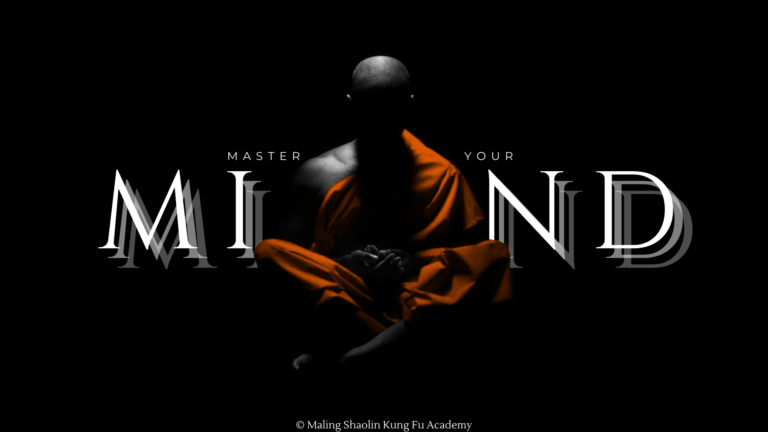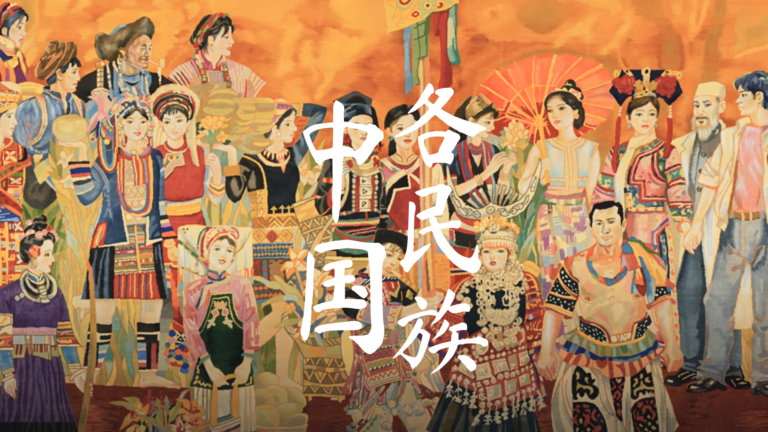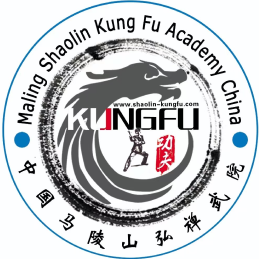The Nature of Change and Pursuit of Harmony
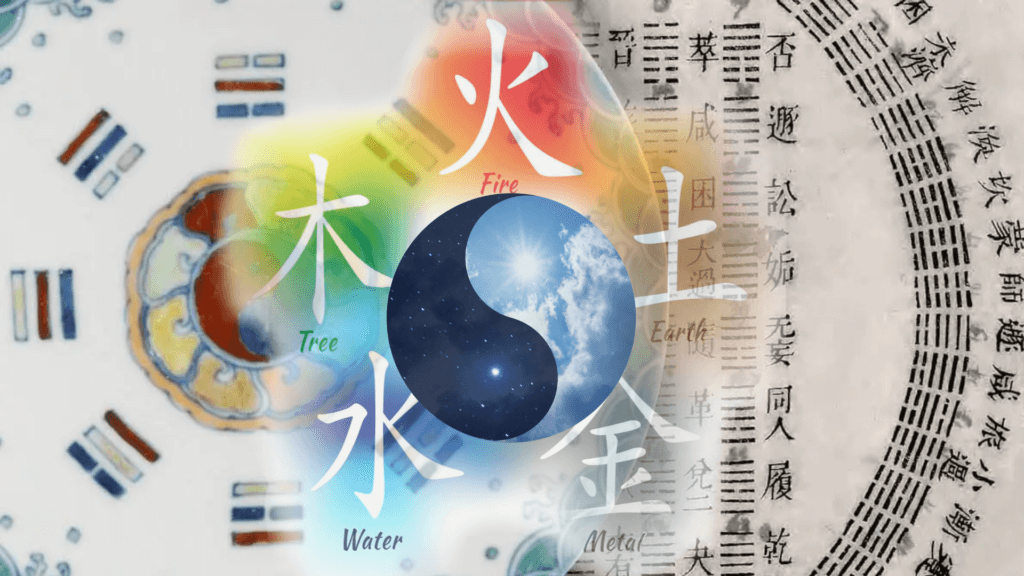
Over time our blog at Maling Shaolin Kung Fu Academy will post articles related not only to Kung Fu, but Chinese culture, tradition, history, legends, media, and philosophies. While Kung Fu remains at the core of our practice and teachings, we recognize that true understanding and appreciation of this ancient martial art extend beyond physical techniques. By exploring a diverse range of topics, we aim to provide a holistic view of Chinese heritage and its influence on martial arts, fostering a deeper connection with our students and readers. Through these articles, we hope to inspire curiosity, broaden perspectives, and promote a greater understanding of the rich tapestry of Chinese culture and its profound impact on the world.
In this article, we delve into the philosophy of Yi Jing.
The Yi Jing, also known as the I Ching or the Book of Changes, is an ancient Chinese divination text and one of the oldest Chinese classics. It has been a fundamental source of Chinese philosophy, cosmology, and metaphysics for over 3,000 years. The Yi Jing consists of a set of 64 hexagrams, each made up of six lines, either broken (yin) or unbroken (yang).
Overview: Key Concepts and Aspects
- Yin and Yang: The fundamental concept of Yin and Yang underlies the philosophy of the Yi Jing. Yin and Yang represent the dualistic nature of existence – opposite and complementary forces. Yin is associated with receptivity, darkness, and the feminine, while Yang is associated with activity, light, and the masculine. The hexagrams are combinations of Yin and Yang lines.
- Change and Transformation: The central theme of the Yi Jing is change. The hexagrams represent different situations and states, and the changing lines within them indicate the dynamic nature of life. The philosophy emphasizes that change is inevitable and that understanding and adapting to these changes is crucial for harmonious living.
- Divination and Oracle: While the Yi Jing is often associated with divination and fortune-telling, its deeper purpose is to provide guidance and insights into the natural flow of events. Users would traditionally cast coins or use yarrow sticks to generate a hexagram, and then consult the text for interpretations.
- Trigrams and Hexagrams: The hexagrams are formed by combining two sets of trigrams (three-line figures). Trigrams represent basic natural forces, and their combinations in the hexagrams convey more complex situations. Each hexagram is accompanied by a divinatory text that offers guidance and insights into the specific situation it represents.
- Five Elements and Eight Trigrams: The Yi Jing is also connected to the Chinese cosmological system of the Five Elements (Wood, Fire, Earth, Metal, Water) and the Eight Trigrams, which are combinations of three Yin or Yang lines representing specific natural forces and phenomena.
- Ethical and Moral Guidance: The Yi Jing provides ethical and moral guidance, emphasizing virtues such as humility, sincerity, and adaptability. It encourages individuals to align their actions with the natural order and to cultivate virtues that lead to a harmonious and balanced life.
- Holistic View of Reality: The Yi Jing offers a holistic view of reality, seeing the interconnectedness of all things. It suggests that events are not isolated occurrences but part of a larger pattern, and understanding this pattern allows individuals to navigate life more effectively.
Structure & Composition
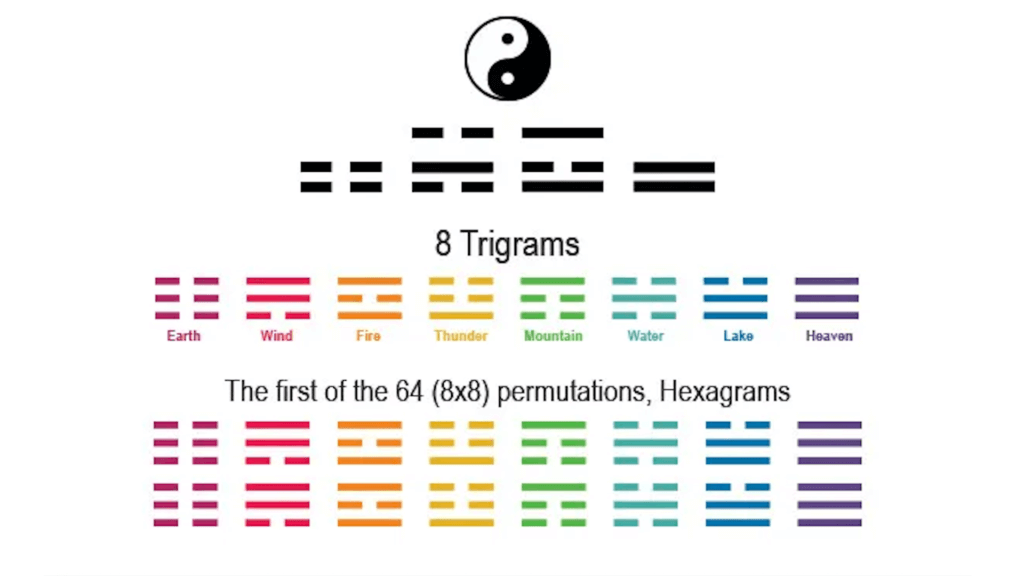
Hexagrams
Symbolism and Meaning:
The Yi Jing comprises 64 hexagrams, each consisting of six stacked lines, either broken (yin) or solid (yang). These hexagrams are symbolic representations of various archetypal situations, conditions, and phenomena encountered in life.
Binary System:
The hexagrams are built upon a binary system, where each line represents either yin (a broken line) or yang (a solid line). This binary nature reflects the fundamental duality and complementary nature of existence, with yin representing receptivity, darkness, and the feminine principle, and yang representing activity, light, and the masculine principle.
Line Changes:
Within each hexagram, individual lines can change, resulting in the creation of a new hexagram. These line changes represent the dynamic nature of reality and the continuous process of change and transformation. Each line change adds layers of nuance and complexity to the hexagram’s overall meaning.
Trigrams
Fundamental Elements:
The hexagrams are constructed from combinations of eight trigrams, each composed of three lines. These trigrams represent fundamental elements and forces of nature, offering a symbolic language to describe the dynamics of the universe.
Symbolism and Interpretation:
Each trigram carries its own symbolic meaning and represents specific aspects of nature and human experience. For example, the trigram ☰ (heaven) symbolizes strength, power, and creativity, while ☵ (water) represents fluidity, adaptability, and the flow of energy.
Combinations to Form Hexagrams:
The trigrams are combined in pairs to form hexagrams, resulting in a total of 64 possible combinations. Each hexagram represents a unique configuration of elemental forces and offers insights into the underlying patterns and dynamics of a situation.
Line Changes
Dynamic Interplay:
Line changes within hexagrams represent shifts in the underlying energies and influences at play in a given situation. A changing line can indicate a moment of transition, challenge, or opportunity, altering the overall interpretation of the hexagram.
Moving Lines:
When a line changes within a hexagram, it creates a new hexagram, known as the transformed hexagram. This transformed hexagram provides additional insights and guidance, building upon the symbolism of the original hexagram while incorporating the nuances introduced by the changing line.
Interpretive Depth:
Line changes add depth and complexity to the divinatory process, allowing for a more nuanced understanding of the querent’s question or situation. Practitioners of the Yi Jing carefully analyze line changes to uncover hidden meanings and gain clarity on the dynamics at play.
Philosophical Foundation
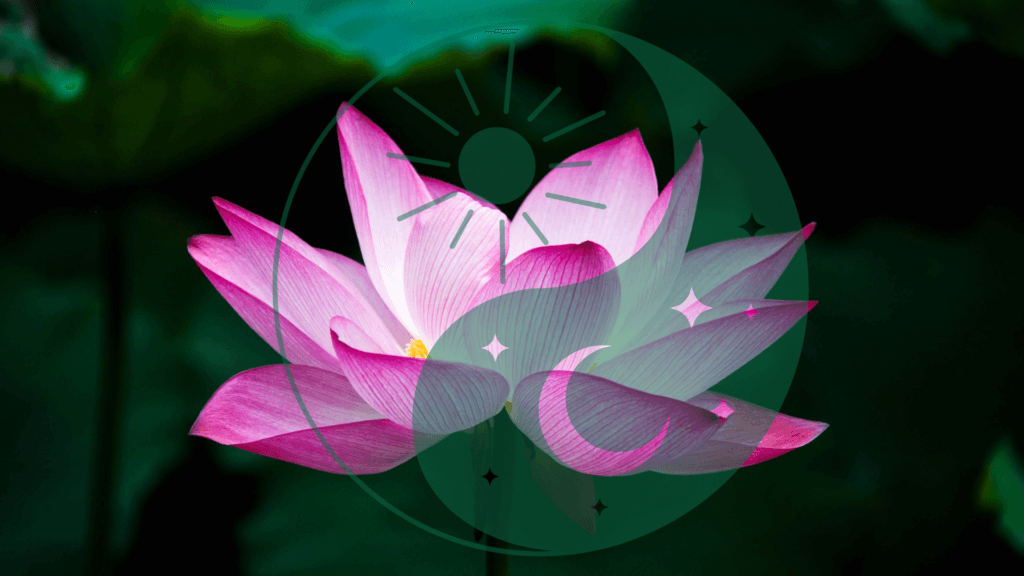
Yin-Yang Philosophy:
Central to the Yi Jing, Yin and Yang are conceptualized as opposite and complementary forces, representing the dualistic nature of existence. They are interdependent and mutually transformative, with neither existing in isolation. Instead, they exist in dynamic equilibrium, constantly influencing and balancing each other. The interaction and balance of these forces underpin the principles of change and harmony.
- Yin is associated with qualities such as receptivity, darkness, passivity, femininity, and the internal. It represents the receptive aspect of nature, embodying qualities of stillness, introspection, and nurturing. Yin energy is often likened to the qualities of water, the moon, and the night.
- Yang, on the other hand, is associated with qualities such as activity, light, assertiveness, masculinity, and the external. It represents the active aspect of nature, embodying qualities of movement, expansion, and expression. Yang energy is often likened to the qualities of fire, the sun, and the day.
- The concept of Yin and Yang emphasizes the dynamic interplay and interdependence between opposites. Within Yin, there is always a seed of Yang, and within Yang, there is always a seed of Yin. This interplay is symbolized by the Taijitu, or yin-yang symbol, which depicts the continuous cycle of transformation between the two forces.
- The presence of Yin and Yang lines within a hexagram offers insights into the underlying dynamics of a situation. The interaction between Yin and Yang lines within a hexagram provides guidance on how to navigate challenges, make decisions, and achieve harmony and balance.
- In divination with the Yi Jing, the presence of Yin and Yang lines is carefully considered to interpret the symbolic meaning of each hexagram. The arrangement of Yin and Yang lines within a hexagram reflects the specific energies and influences at play in a given situation, guiding the querent toward understanding and insight.
Five Elements Theory:
The Yi Jing is also influenced by the theory of the five elements (wood, fire, earth, metal, water), which correspond to different aspects of nature and human experience. These elements interact in cycles of creation and destruction, shaping the dynamics of change and transformation.
Fundamental Forces & Aspects VS Elements

The trigrams in the Yi Jing, such as thunder, wind, lake, etc., represent fundamental forces and aspects of nature, whereas the theory of the five elements (wood, fire, earth, metal, water) is a separate concept that categorizes elements based on their attributes and interactions. Here’s a breakdown of the differences between the trigram elements and the theory of the five elements:
Trigrams in the Yi Jing
Representation of Natural Phenomena:
The trigrams in the Yi Jing symbolize natural phenomena and elemental forces, offering a symbolic language to describe the dynamics of the universe. Each trigram represents a particular aspect of nature, such as thunder representing movement and activity, wind symbolizing gentleness and flexibility, and lake representing receptivity and tranquility.
Combinations to Form Hexagrams:
The trigrams are combined in pairs to form hexagrams, each hexagram representing a unique situation or condition. These combinations reflect the interplay of different elemental forces and their influence on events and circumstances.
Symbolism and Interpretation:
In divination and interpretation, the trigrams offer rich symbolism and insights into the underlying dynamics of a situation. They are interpreted within the context of hexagrams, providing guidance and understanding through their symbolic meanings.
Theory of the Five Elements
Categorization of Elements:
The theory of the five elements categorizes elements—wood, fire, earth, metal, and water—based on their attributes, properties, and interactions. Each element represents specific qualities and phenomena in both nature and human experience.
Cycle of Creation and Destruction:
The five elements are arranged in a cycle of creation and destruction, where each element generates or overcomes another in a continuous cycle of transformation. For example, wood feeds fire, fire creates earth (ash), earth bears metal, metal collects water (as a container), and water nourishes wood.
Application in Traditional Chinese Medicine and Philosophy:
The theory of the five elements is deeply ingrained in traditional Chinese medicine, philosophy, and cosmology. It is used to understand the relationships between different aspects of existence, including the human body, emotions, seasons, and natural phenomena.
Differences
Nature of Representation:
Trigrams in the Yi Jing represent specific elemental forces and aspects of nature, whereas the theory of the five elements categorizes elements based on their qualities and interactions within a cyclical framework.
Number and Categorization:
Trigrams consist of eight distinct symbols representing different natural phenomena, while the theory of the five elements focuses on categorizing elements into five fundamental types based on their attributes.
Interpretive Framework:
Trigrams are primarily used within the context of divination and symbolic interpretation in the Yi Jing, whereas the theory of the five elements serves as a framework for understanding relationships and interactions between elements in various domains, including medicine, philosophy, and cosmology.
In summary, while both the trigrams in the Yi Jing and the theory of the five elements are integral aspects of Chinese cosmology and philosophy, they serve different purposes and offer unique insights into the workings of the universe and human experience.
Methods of Divination
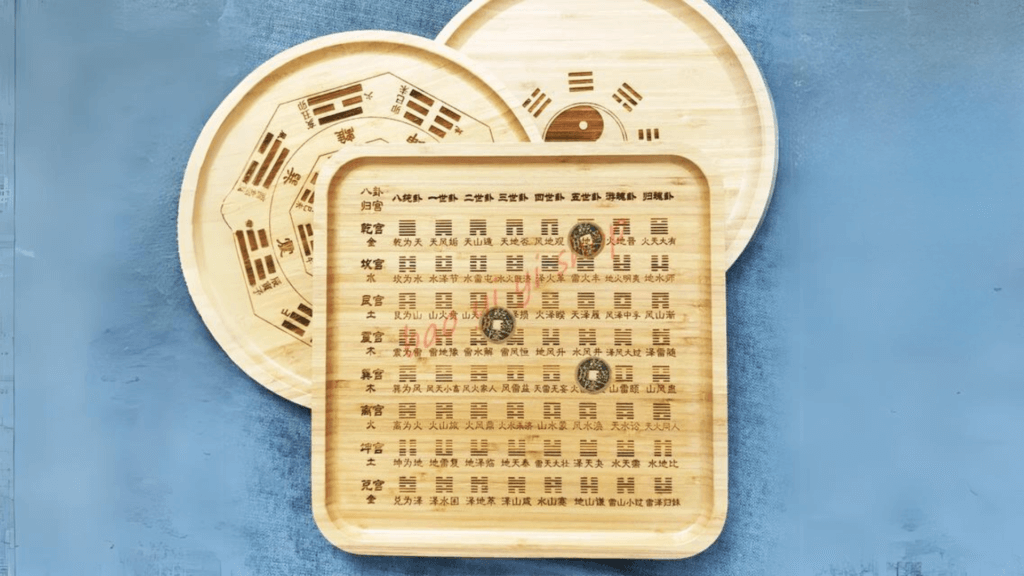
Yarrow Stalk Method:
Traditionally, divination with the Yi Jing involves the use of yarrow stalks, where the querent manipulates a bundle of yarrow stalks to generate hexagrams through a series of prescribed steps.
Coin Toss Method:
In modern practice, coin tosses or random number generators are often used to generate hexagrams. Querents meditate on their question while performing the divination process, seeking guidance and insight into their situation.
Interpretation and Application
Consulting the Oracle:
After generating a hexagram, the querent refers to interpretations provided in Yi Jing texts to discern its meaning. Each hexagram contains layers of symbolism and wisdom that offer guidance on navigating challenges, making decisions, and understanding the underlying patterns of life.
Personal Development:
Beyond divination, the Yi Jing serves as a tool for personal growth and self-reflection. Practitioners study its teachings to cultivate virtues such as wisdom, resilience, and adaptability, aligning their actions with the principles of harmony and balance.
Modern Relevance
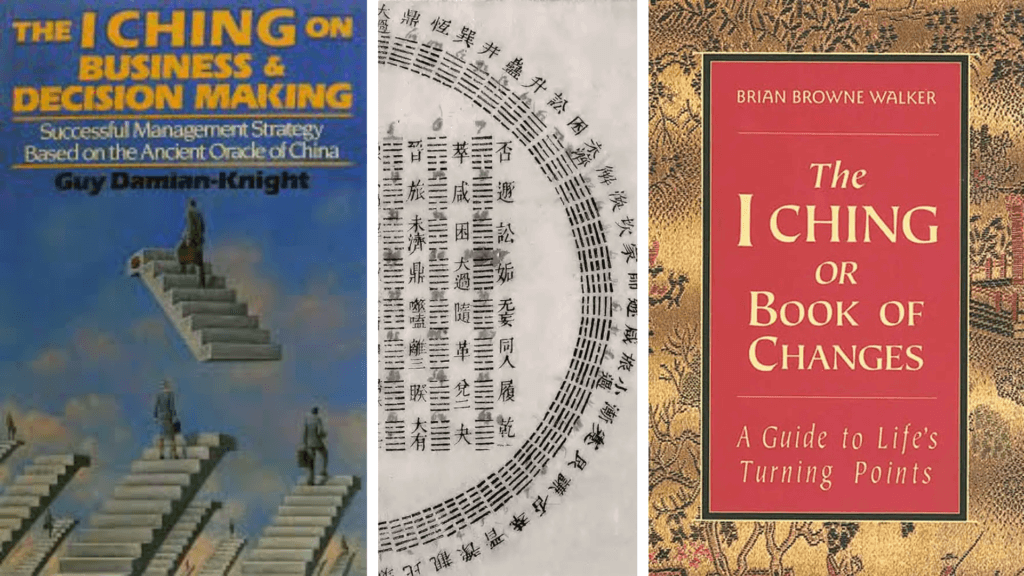
Psychological Insights
The Yi Jing has found applications in psychology, with its symbols and archetypes interpreted through the lens of analytical psychology and depth psychology. It offers insights into the unconscious mind, patterns of behavior, and the integration of opposites.
Analytical Psychology:
Psychologists and therapists often use the Yi Jing as a tool for self-reflection, introspection, and gaining insights into the unconscious mind. The symbolic language of the Yi Jing, with its hexagrams, trigrams, and line changes, provides a rich framework for exploring psychological themes and archetypes.
Example: A psychologist might use the Yi Jing in therapy sessions to help clients explore unconscious patterns, unresolved conflicts, and personal growth opportunities. By reflecting on the symbolic meanings of hexagrams and line changes, clients can gain deeper insights into their thoughts, feelings, and behaviors.
Depth Psychology:
Practitioners of depth psychology, such as those influenced by the work of Carl Jung, often draw upon the Yi Jing as a source of archetypal symbolism and collective unconscious imagery. The hexagrams and trigrams of the Yi Jing resonate with universal themes and motifs found in dreams, myths, and cultural symbols.
Example: A Jungian analyst might interpret a client’s dreams using the symbols and themes found in the Yi Jing. By exploring the parallels between the client’s dream imagery and the symbolic language of the Yi Jing, the analyst can uncover deeper layers of meaning and facilitate the client’s journey toward self-discovery and integration.
Business and Decision-Making
Strategic Planning:
Business leaders and executives often consult the Yi Jing for strategic planning, problem-solving, and decision-making. The Yi Jing offers a holistic framework for understanding complex situations, anticipating challenges, and identifying opportunities for growth and innovation.
Example: A business owner facing a difficult decision, such as whether to expand into a new market or launch a new product, might consult the Yi Jing for guidance. By generating a hexagram and interpreting its symbolic meaning, the business owner can gain insights into the potential risks, benefits, and outcomes of different courses of action.
Risk Management:
The Yi Jing can also be used as a tool for risk management and scenario analysis in business contexts. By considering various hexagrams and their associated meanings, business professionals can assess potential risks, uncertainties, and market dynamics, enabling them to make more informed decisions.
Example: A project manager tasked with evaluating the feasibility of a new project might use the Yi Jing to explore different scenarios and potential outcomes. By consulting the Yi Jing, the project manager can identify potential risks, develop contingency plans, and make strategic adjustments to minimize uncertainties and maximize success.
Conclusion
In our exploration of the Yi Jing, also known as the Book of Changes, we’ve uncovered the timeless wisdom embedded within its pages, from its foundational concepts of Yin and Yang to its practical applications in psychology and business. Central to its philosophy is the recognition of change as an inherent aspect of existence, guiding us through the ebbs and flows of life’s journey. Through its symbolic language of hexagrams and trigrams, the Yi Jing offers profound insights into the dynamics of human nature and the principles of harmony and balance. In the modern world, its teachings find new relevance, serving as a tool for self-reflection, decision-making, and navigating complex challenges. As we embrace the wisdom of the Yi Jing, may we find guidance and inspiration to navigate the ever-changing currents of life with wisdom, resilience, and grace.

